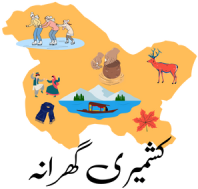Kangri
| Kangri | |

| |
| Classification | Traditional heating device |
| Used With | Winter clothing |
| Origin | Kashmir, India |
The Kangri (Kashmiri: کانٛگری) is a traditional Kashmiri fire pot used for personal heating during the cold winter months. It is typically made of an earthen pot filled with burning charcoal, encased in a woven wicker frame to make it portable and safe for use.
History[edit | edit source]
The Kangri has been a part of Kashmiri culture for centuries, believed to have originated from Central Asia or Italy during the Mughal era. It was traditionally used by Kashmiri people to combat the severe winters of the region.
Design[edit | edit source]
A Kangri consists of two main components:
- Earthenware pot: This holds the burning charcoal.
- Wicker frame: The outer covering is made from finely woven wicker, providing insulation and making the Kangri easier to carry.
The design is simple yet effective, allowing the user to carry it under traditional clothing, such as a pheran.
Usage[edit | edit source]
The Kangri is used to keep warm by holding it close to the body. It is commonly placed under the pheran, the traditional Kashmiri cloak, to trap heat and keep the user comfortable in freezing temperatures.
While it is primarily a utility object, the Kangri is also considered a cultural symbol of Kashmir. It is often exchanged as a gift during winter festivals or used decoratively.
Safety Concerns[edit | edit source]
Improper handling of the Kangri can cause burns or accidents. Users must be cautious to avoid prolonged exposure to direct heat, which can lead to skin injuries.
Cultural Significance[edit | edit source]
In addition to its practical use, the Kangri holds a special place in Kashmiri traditions. It is associated with various rituals and festivities, symbolizing warmth and hospitality.
Modern Adaptations[edit | edit source]
With the advent of modern heating appliances, the use of Kangris has declined in urban areas. However, they remain popular in rural Kashmir due to their affordability and efficiency.
